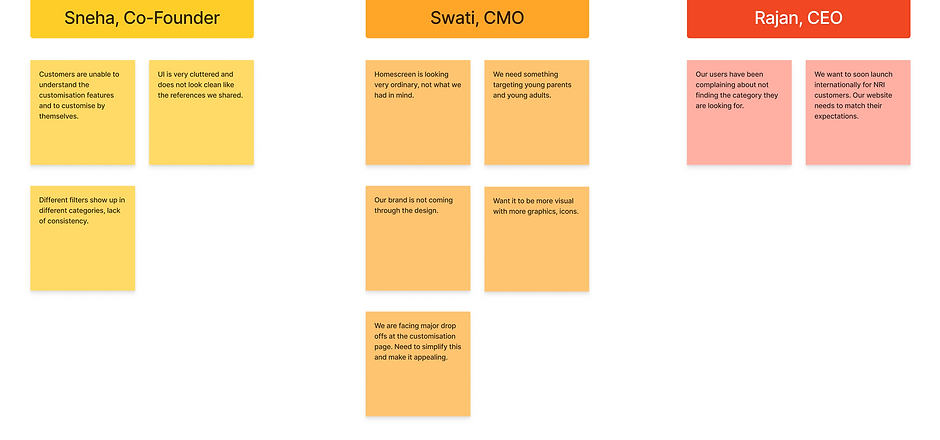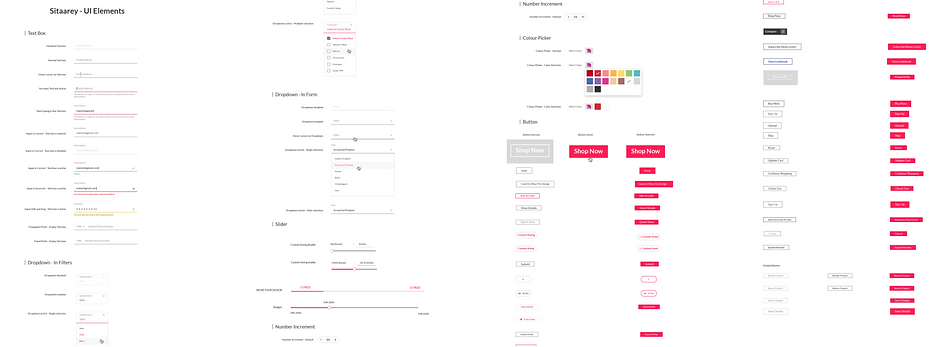Nidhi Aggarwal

Sitaarey
Children Fashion E-commerce
Sitaarey, a kids clothing e-commerce brand specializing in customized outfits for kids and child-parent outfit combos.
Results
150%
INCREASE IN CONVERSION RATES
45%
REDUCTION IN TASK COMPLETION TIME
ROLE
UX Design Lead
CONTRIBUTED WITH
CEO
Co-founders
Web developer
UX Designers
UX Researcher
Graphic Designer
Content Writer
TOOLS
Sketch
Adobe Photoshop
Adobe Illustrator
Invision
Zeplin
GOAL
The goal of this project was to redesign of the Sitaarey e-commerce website and help enhance customer engagement with all the new customization features seamlessly functioning and presented.
BACKGROUND
A successful children's fashion business wanted to take their website to the next level and create a breakthrough in the kids' clothing e-commerce segment with their special new features like outfit customization, Child-Parent Combo outfits and Fit Insurance, which resizes bought clothes up to 2 sizes for growing kids.
I was called to lead a team of designers after they had worked on it for about 8 weeks as the project wasn’t making progress with the client and designs were not meeting their requirements.
The client was looking for a seamless minimal design with all features well highlighted and functional. They wanted a globally appealing website, which could cater to their soon to be added international customers. Their features were highly specialized and we designed the architecture, the pages and the UI for them.
CHALLENGE
I was added to this project much after work had begun and the designs created by then weren't meeting the client's criteria, so had to restructure and guide the team to redesign the project in a short period of time.
The customization features did not have any exact points of reference for our market and we tried to craft a personalised experience.
PROCESS
Since we needed to re-calibrate, I undertook a group requirement gathering session to understand their requirements and feedback.
STAKEHOLDER REQUIREMENT GATHERING
TAKEAWAY FROM STAKEHOLDERS
The main actionable feedback provided to me by the stakeholders at the end of the meet based on the design presented by the team prior to me joining. Most of it was architecture, layout and UI related.

PROCESS
Based on the stakeholder's feedback, I decided to start with conducting a heuristic analysis of the existing design to find further problem areas, which would help us in narrowing our process further.
HEURISTIC ANALYSIS
HEURISTIC ANALYSIS
Upon conducting a heuristic analysis, I uncovered multiple smaller issues too, which needed to be fixed in the redesign.

PROCESS
I used the user research data collected by the team and analyzed it to create fresh personas for each user profile.
USER RESEARCH
USER PERSONAS
We created personas for 4 profiles based on the quantitative and qualitative research data.

PROCESS
We ideated on the feature list and started working on the website design and architecture.
DEFINING
INFORMATION ARCHITECTURE
On analysis, I had found some inconsistencies in the architecture and user flow and so we redesigned the information architecture of the site with adding consistent content flow.

PROCESS
LO-FI PROTOTYPING
With the architecture finalized and our feature lists ready after deliberation with the stakeholders, we started the prototyping process and we initiated it with paper wireframes due to shortage of time. I also wanted to keep the stakeholders involved at each step and the team started sketching the wireframes based on our findings and we kept it quick for us to design and edit based on the stakeholders' inputs.
LO-FI PROTOTYPING
HOME PAGE AND TOP PICKS SECTION

LO-FI PROTOTYPING
PRODUCT CATEGORY PAGE

LO-FI PROTOTYPING
STYLE FIT FLOW

LO-FI PROTOTYPING
KIDS PROFILE SETUP FLOW

PROCESS
We incorporated all the feedback and created the final visuals on these lines.
FINAL VISUALS
LANDING PAGE 1

LANDING PAGE 2

HOME PAGE

PRODUCT CATEGORY PAGE

PRODUCT DETAIL PAGE

PROCESS
We created a design document as a style guide to help the developers get a clear idea of the UI Elements and their different states.
DESIGN DOCUMENTATION
DESIGN DOCUMENTATION

LEARNINGS
1. Ensuring that stakeholders are involved in every step is key to creating a great purposeful product.
2. Always be prepared to look at an existing project with a new lens.